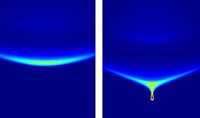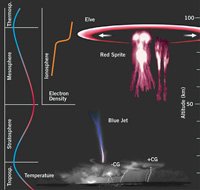
With new simulations Alejandro Luque and Ute Ebert (CWI) explained huge lightning flashes above clouds: sprites. They published their results in Nature Geoscience, which appeared online on 25 October 2009.
Sprites, enormous vertical discharge flashes high up in the atmosphere, emerge through the collapse of a downward moving wave of positively charged particles in the lower region of the ionosphere. This was demonstrated by Alejandro Luque and Ute Ebert at the Centrum Wiskunde & Informatica (CWI), the national centre for mathematics and computer science in Amsterdam, The Netherlands. The research was funded by the Dutch Technology Foundation STW. Luque and Ebert are able to simulate all relevant structures in the discharge, from inner features of 2 metres up to the full earth-ionosphere distance of 90 km, within the same computer program. They include the changes of air density and electron density with altitude, as well as the electric fields generated by cloud-to-ground lightning. Their predictions match present observations very well. Their findings are published on 25 October 2009 as an Advance Online Publication on the Nature Geoscience website.
The development of a sprite as captured by a very fast camera. Source Steven A. Cummer et al., Geophysical Research Letters, vol.33, L04104.
In 1925, the Scottish researcher Charles Wilson – Nobel Prize winner and inventor of the so-called cloud chamber that was much used in the early search for elementary particles – predicted that electric discharges could occur not only between thunderclouds and ground, but also in the much thinner air high above thunderclouds. There were also sporadic reports of strange flashes above thunderclouds, but it was in 1990 when such flashes were first described in scientific literature. The most frequent types are elves and sprites. Observations with ultrafast movie cameras show that sprites emerge at altitudes of 70 to 90 km, at the lower end of the ionosphere. From there they shoot tens of kilometers down. Sometimes there is a second stage in which they shoot up again. But their emergence was not really understood. When do they emerge? How thick are they and how fast? How much light do they emit? Why is there sometimes a diffuse glow (called halo) before these huge lightning flashes? Luque and Ebert answer these questions with their new computer simulations.

Light emitted from the developing sprite according to the simulation. Illustration Nature Geoscience.
Halo breaking up
A lightning stroke from cloud to ground creates an electric field above the cloud. In this field the sprite discharge emerges. Shape and light intensity in the simulations of Luque and Ebert match the observations very well. Their numerical solutions show how at the lower edge of the ionosphere – the atmospheric layer containing electrically charged particles – first a wide bowl-shaped halo emerges, extending over tens of kilometers in the horizontal direction. The 'bowl' moves downward, while its lower edge becomes increasingly sharp. The local electric forces render the sharp lower edge unstable. Out of this destabilizing front, a discharge channel shoots downwards with a velocity as large as 10.000 kilometers per second and a diameter of hundreds of meters – a huge sprite discharge. After a few kilometers of downward propagation, the discharge channel becomes unstable and breaks up. This is how the heavily branched structure of the sprite discharge emerges. The simulations of Luque and Ebert can now reproduce the complete time sequence from causative lightning stroke through halo bowl to emerging sprite discharge.
Ignorosphere
Sprite discharges occur at a very inaccessible altitude in the atmosphere (40 to 90 kilometer above ground). This altitude is sometimes named the 'ignorosphere' because it is too high for aircraft and balloons and too low for satellites. The researchers from Amsterdam now can model the complete relevant altitude of the atmosphere from 0 to 90 km. In the same computer program they can also resolve discharge channels of hundreds of meters wide with inner layers of only few meters. Predictions of such strong computer programs together with new observations increase our understanding of this inaccessible part of our atmosphere.

Sprites and other discharge phenomena, high in the atmosphere (represented schematically). Illustration Torsten Neubert/ESA.
More information: Prof. dr. Ute Ebert (Centrum Wiskunde & Informatica - CWI, and Eindhoven University of Technology), head of the research group Multiscale Modelling and Nonlinear Dynamics at CWI, e-mail e-mail Ute.Ebert (at) cwi.nl.
Reference: Emergence of sprite streamers from screening-ionization waves in the lower ionosphere, A. Luque en U. Ebert, Nature Geoscience, AOP 25 oktober 2009.
Movies of the simulations can be downloaded via: http://homepages.cwi.nl/~ebert/ne.avi and http://homepages.cwi.nl/~ebert/E.avi . "A halo slowly builds up, moves downwards and breaks. From that point a sprite flashes downwards." Source: Centrum Wiskunde & Informatica (CWI).
Source of this news item:
Centrum Wiskunde & Informatica (CWI) and the Technology Foundation STW
- Founded in 1946, Centrum Wiskunde & Informatica (CWI) is the national research institute for mathematics and computer science in the Netherlands. It is located at Science Park Amsterdam and is part of the Netherlands Organisation for Scientific Research (NWO). The institute is internationally focused and renowned. Over 160 researchers conduct pioneering research in about 70 projects and share their acquired knowledge with society. The institute has generated twenty spin-off companies.
- Technology Foundation STW is the Dutch funding agency for basic research with a promising application potential. With an annual budget of about 80 million euros STW funds research projects and programmes at all Dutch academic institutions. Every project is guided by a committee of researchers and potential knowledge users to foster knowledge transfer to industry and society.
